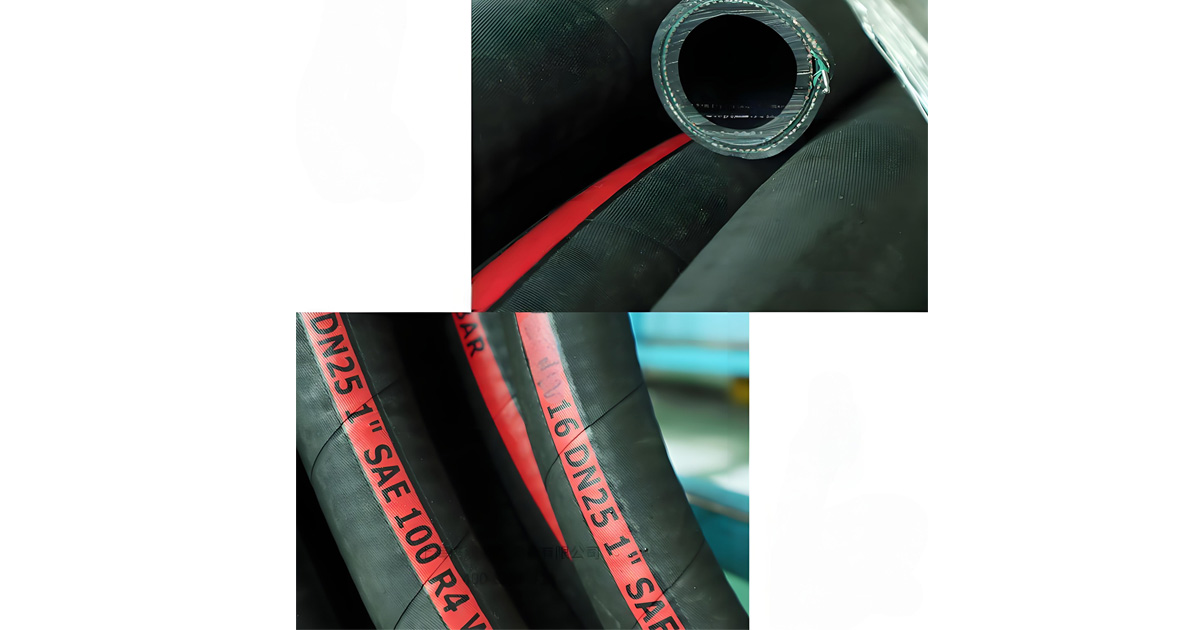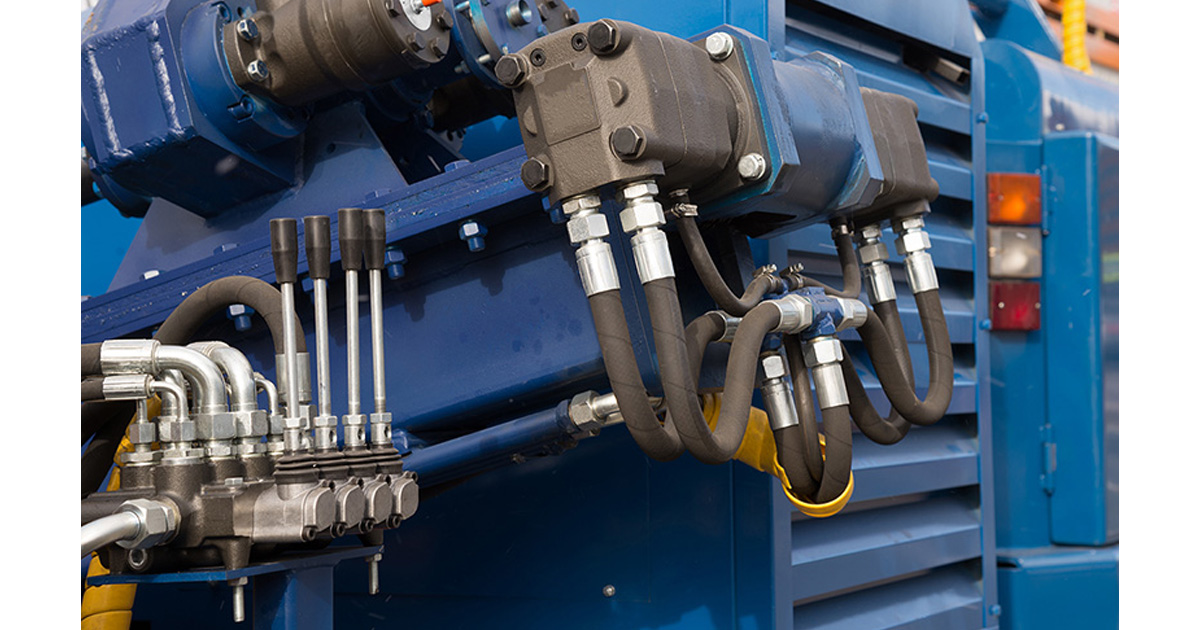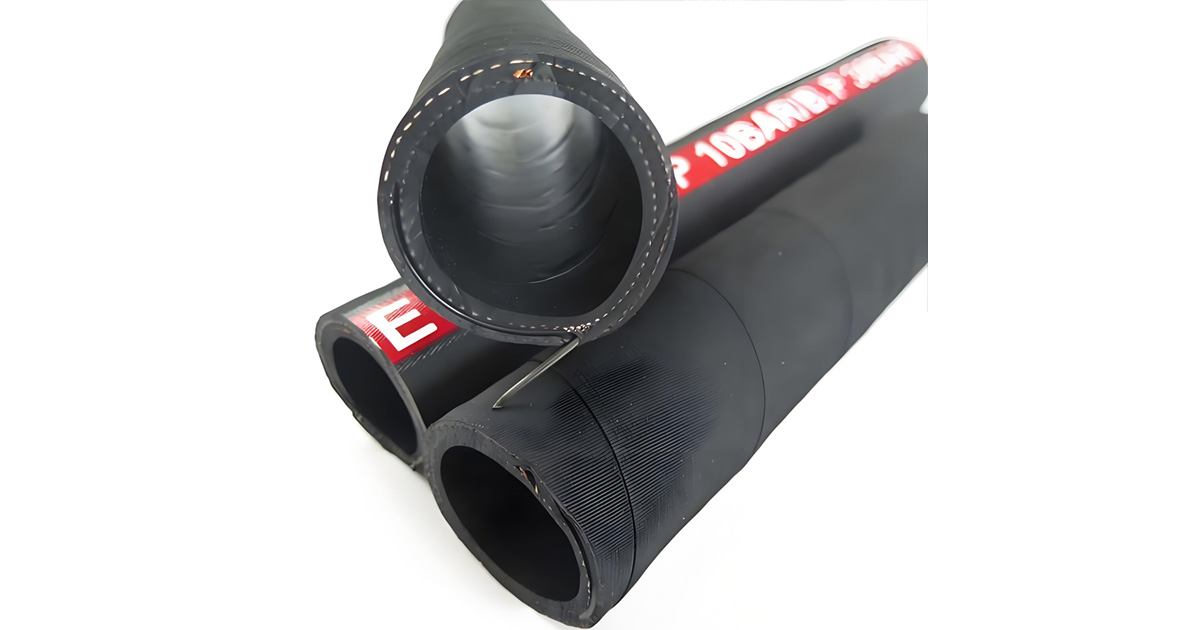У гідраўлічнай сістэме вяртанне рабочай вадкасці рэдка праходзіць па тым жа шляху, што і пры ціску (напрыклад, у простым гідраўлічным дамкраты). Часцей за ўсё вадкасць перапампоўваецца па адной лініі, выконвае сваю працу, а затым вяртаецца ў рэзервуар па асобнай трубе. ўсмоктвальны і зваротны шлангВось тут і патрэбныя гідраўлічныя зваротныя шлангі.

Зваротныя шлангі выраблены з гумы, таксама вядомы як шлангі вяртання гідраўлічнага алеюЗваротныя шлангі ніжэйшы ціск, чым у звычайных гідраўлічных шлангах, і яны павінны быць устойлівымі да нафты, каб яны маглі транспартаваць розныя гідраўлічныя вадкасці і асяроддзя на аснове нафты. Іх армавальны пласт складаецца з тэкстыльнай аплёткі або тканых слаёў замест сталёвага дроту, і яны спалучаюцца са спіральным сталёвым дротам, каб зрабіць іх больш гнуткімі і трывалымі.
Выбар правільных ўсмоктвальных і зваротных шлангаў важны для гідраўлічнай сістэмы. Гэтыя шлангі перадаюць вадкасць паміж гідраўлічнымі кампанентамі. У гэтым кіраўніцтве мы абмяркуем, што такое гідраўлічныя ўсмоктвальныя і зваротныя шлангі, іх функцыі і як іх выбраць.
Што такое гідраўлічны ўсмоктвальны шланг?
Усмоктвальная лінія злучае гідраўлічны рэзервуар з помпай, забяспечваючы бесперабойную падачу вадкасці ў помпу. Яе асноўная функцыя — забяспечваць бесперапынную падачу гідраўлічнага алею пад нізкім ціскам, прадухіляючы перапынкі, якія могуць прывесці да пашкоджання помпы.
Асноўныя меркаванні адносна ўсмоктвальнага шланга
Усмоктвальныя шлангі вырабляюцца з сінтэтычнага каўчуку або тэрмапластычных матэрыялаў. Яны ў асноўным выкарыстоўваюцца ў гідраўлічных вакуумных сістэмах. Шланг гнуткі і трывалы. Такім чынам, ён можа прадухіліць разбурэнне, калі помпа ўсмоктвае вадкасць.
Унутраны дыяметр ўсмоктвальнага шланга павінен быць дастаткова вялікім для лепшай працы. Калі ўнутраны дыяметр зваротнага шланга занадта малы, гэта абмяжуе паток, што прывядзе да галадання помпы, кавітацыі і заўчаснага выхаду з ладу помпы.
Вам варта пераканацца, што матэрыял зваротнага шланга сумяшчальны з гідраўлічнай вадкасцю. Несумяшчальнасць можа прывесці да ўздуцця шланга, яго пагаршэння якасці, зніжэння прадукцыйнасці і паломкі гідраўлічнай сістэмы.
Усмоктвальныя шлангі павінны мець шырокі дыяпазон тэмператур і ўзровень вакууму гідраўлічнай сістэмы. Перад устаноўкай неабходна пераканацца ў намінальнай тэмпературы і ціску шланга, каб забяспечыць надзейную працу ў працоўных умовах.
Што такое гідраўлічны зваротны шланг?
Зваротны шланг пераносіць гідраўлічную вадкасць ад кампанентаў гідраўлічнай сістэмы назад у рэзервуар. Ён адрозніваецца ад стандартнага гідраўлічнага шланга тым, што зваротныя шлангі працуюць пад нізкім ціскам, але павінны мець высокую хуткасць патоку.
Асноўныя меркаванні адносна зваротных шлангаў
Памер зваротных шлангаў павінен быць дастаткова вялікім, каб вытрымліваць празмерны зваротны ціск ад вялікіх аб'ёмаў вадкасці. Выбар шланга з адпаведным унутраным дыяметрам забяспечвае плаўны паток і эфектыўную працу сістэмы, асабліва падчас пікавых патокаў.
Зваротныя шлангі вытрымліваюць меншы ціск у параўнанні са стандартнымі гідраўлічнымі шлангамі. Але яны таксама павінны працаваць у адпаведнасці з гідраўлічнай сістэмай, бо гідраўлічная сістэма лёгка паддаецца скачкам або ваганням ціску.
Зваротныя шлангі заўсёды падвяргаюцца ўздзеянню складаных умоў навакольнага асяроддзя. Выбар абалонак, устойлівых да ізаляцыі, і шлангаў, устойлівых да надвор'я, можа забяспечыць працяглы тэрмін службы і знізіць патрабаванні да тэхнічнага абслугоўвання.
Асноўныя адрозненні паміж ўсмоктвальным і зваротным шлангамі
Усмоктвальныя трубы выкарыстоўваюцца ў вакууме і пры нізкім ціску. Калі вы выбераце шланг нізкай якасці або выкарыстоўваеце яго пры ціску, які перавышае намінальны дыяпазон, шланг можа разбурыцца.
Зваротныя трубаправоды таксама выкарыстоўваюцца ў асяроддзях з нізкім ціскам, але яны патрабуюць вялікай хуткасці патоку і ўстойлівыя да алею.
Абодва шлангі ўзмоцнены тэкстыльнай аплёткай, але труба для ўсмоктвання алею таксама ўзмоцнена спіральным дротам, каб прадухіліць зрушэнне.
| Черта | Ўсмоктвальны шланг | Зваротны шланг |
| Функцыя | Злучае рэзервуар з помпай; падае алей на ўваход помпы | Пасля працы сістэмы вяртае алей у рэзервуар |
| Рабочы ціск | Працуе пад вакуумам/нізкім ціскам | Працуе пад нізкім ціскам, але павінен спраўляцца з скокамі |
| Характарыстыкі патоку | Павінна прадухіліць абвальванне пад усмоктваннем | Павінен спраўляцца з высокімі хуткасцямі патоку без супрацьціску |
| Арматурная канструкцыя | Часта армаваны спіральным дротам + тэкстыльнымі пластамі | Звычайна тэкстыльная аплётка або пласты тканіны; часам тонкая спіраль з дроту |
| Асноўныя рызыкі | Кавітацыя, недапрацоўка помпы, разбурэнне шланга, трапленне паветра | Залішні зваротны ціск, уцечка, пашкоджанні ад ізаляцыі |
| Патрабаванні да матэрыялаў | Масластойкі, вакуумстойкі, гнуткі матэрыял | Алейаўстойлівае, устойлівае да ізаляцыі, устойлівае да надвор'я пакрыццё |
| Тыповыя меркаванні па праектаванні | Вялікі ўнутраны ўнутр для мінімізацыі падзення ціску; вытрымлівае вакуум | Памер падабраны для пікавай прапускной здольнасці; рэкамендуецца фільтрацыя |
Функцыі гідраўлічных усмоктвальных і зваротных шлангаў
У гідраўлічнай сістэме алей паступае з бака да прывадаў, такіх як гідраўлічныя цыліндры, каб выконваць працу. Пасля гэтага алей павінна вярнуцца ў бак. Такім чынам, помпа і іншыя дэталі могуць працягваць працаваць. Асноўная задача зваротнай лініі, напрыклад, у экскаватарах, — адпраўляць алей назад у бак. Гэта забяспечвае рух алею і працаздольнасць сістэмы.
2. Балансаванне ціску
Зваротная лінія таксама дапамагае падтрымліваць стабільны ціск. Калі працуюць прывады, алей сутыкаецца з рознымі ўзроўнямі ціску. Каб сістэма працавала бяспечна і стабільна, гэтыя ўзроўні ціску павінны выраўноўвацца. Зваротная лінія адводзіць лішні ціск і падтрымлівае баланс сістэмы. Гэта забяспечвае ёй плаўную і надзейную працу.
3. Цеплааддача
Калі сістэма працуе, алей награваецца. Калі алей награваецца занадта моцна, эфектыўнасць сістэмы зніжаецца, і дэталі хутчэй зношваюцца. Зваротная лінія дапамагае астудзіць алей, перамяшчаючы яго назад у бак. Алей астуджаецца альбо ў самым баку, альбо праз ахаладжальнік. Гэта падтрымлівае тэмпературу на патрэбным узроўні.

Як вызначыць правільныя гідраўлічныя ўсмоктвальныя і зваротныя шлангі
Выбар найлепшых усмоктвальных і зваротных шлангаў патрабуе ўліку патрабаванняў да сістэмы, характарыстык шлангаў і ўмоў эксплуатацыі. Вось пакрокавае кіраўніцтва:
Выбіраючы ўсмоктвальныя і зваротныя шлангі, спачатку праверце, што патрабуецца сістэме. Звярніце ўвагу на працоўны ціск і тэмпературу. Вымерайце найбольшы паток ва ўсмоктвальнай і зваротнай лініях. Таксама падумайце пра навакольнае асяроддзе. Шланг можа падвяргацца ўздзеянню цяпла, холаду, ізаляцыі або хімічных рэчываў.
Далей выберыце патрэбны памер шланга. Падбярыце ўнутраны дыяметр у адпаведнасці з патокам і ціскам. Ва ўсмоктвальных лініях падтрымлівайце нізкі перапад ціску, каб пазбегнуць кавітацыі. У зваротных лініях пераканайцеся, што шланг можа вытрымліваць пікавы паток без супрацьціску.
Матэрыял шланга павінен адпавядаць вадкасці. Варта выкарыстоўваць шлангі, якія выкарыстоўваюцца для нафтавай нафты, сінтэтычнай нафты або біяраскладальнай нафты.
Стандарт SAE або ISO з'яўляецца асноўным стандартам для вашага ўсмоктвальнага і зваротнага шланга. Гэта робіць сістэму бяспечнай і надзейнай.
Усталюйце шланг, выкарыстоўваючы якасныя фітынгі і злучальнікі, каб прадухіліць уцечкі. Выкарыстоўвайце хамуты або кранштэйны, каб зафіксаваць шланг, каб ён не дрыжаў і не церся.
| Крок | Ключавыя моманты |
| Зразумець сістэмныя патрабаванні | - Вызначыць працоўны ціск і тэмпературу - Вымерайце максімальную хуткасць патоку ў ўсмоктвальнай і зваротнай лініях - Ацаніць фактары навакольнага асяроддзя (спёка, холад, хімічныя рэчывы) |
| Выберыце правільны памер шланга | - Выкарыстоўвайце дыяграмы ўнутранага аб'ёму шлангаў, каб супаставіць хуткасць патоку і ціск - Для ўсмоктвальных ліній: мінімізаваць падзенне ціску, каб прадухіліць кавітацыю - Для зваротных ліній: забяспечыць прапускную здольнасць для пікавага патоку без супрацьціску |
| Звярніце ўвагу на сумяшчальнасць | - Праверце сумяшчальнасць матэрыялу шланга з гідраўлічнай вадкасцю - Выберыце шлангі для алеяў на аснове нафты, сінтэтычных або біяраскладальных алеяў |
| Праверце сертыфікаты і стандарты | - Пераканайцеся, што шлангі адпавядаюць стандартам SAE або ISO - Надзейнасць і бяспека залежаць ад сертыфікаваных шлангаў |
| Улічвайце патрабаванні да зборкі шланга | - Выкарыстоўвайце высакаякасныя фітынгі/злучальнікі, каб паменшыць уцечкі - Замацуйце шлангі хамутамі/кранштэйнамі, каб мінімізаваць вібрацыю і знос |
Тыповыя памылкі, якіх варта пазбягаць пры выбары ўсмоктвальных і зваротных шлангаў
Выкарыстанне занадта малых шлангаў можа выклікаць праблемы. Калі шланг з'яўляецца зваротнай лініяй, паток абмежаваны, і гэта стварае супрацьціск. Занадта вялікі супрацьціск зніжае ціск вышэй па плыні. Гэта можа прывесці да перагрэву, зніжэння эфектыўнасці і нават пашкоджання дэталяў.
Калі шланг з'яўляецца ўсмоктвальнай лініяй, малы памер абмяжоўвае паток на ўваходзе помпы. Гэта можа стварыць адмоўны ціск або вакуум. Тады ў помпе можа ўтварыцца кавітацыя. Кавітацыя можа пашкодзіць помпу, знізіць прадукцыйнасць сістэмы і панізіць ціск у сістэме.
Неправерка намінальнага ціску таксама з'яўляецца рызыкай. Усмоктвальныя і зваротныя шлангі працуюць пры ніжэйшым ціску, чым падаючыя шлангі, але калі перавысіць іх мяжу, яны могуць выйсці з ладу або нават лопнуць.
Яшчэ адна памылка — ігнараванне фільтраў. Калі не ўсталяваць фільтры зваротнага трубаправода, бруд і іншыя забруджванні будуць працягваць рухацца па сістэме. Гэта прыводзіць да больш хуткага зносу дэталяў і скарачае тэрмін службы гідраўлічнай сістэмы.
Агульныя сферы прымянення гідраўлічных усмоктвальных і зваротных шлангаў
Гідраўлічныя шлангі выкарыстоўваюцца для перадачы вадкасцей у гідраўлічных сістэмах. Выбар правільнага шланга важны для працы гідраўлічнай сістэмы і тэрміну службы шланга. Вось некаторыя спосабы выкарыстання ўсмоктвальных і зваротных шлангаў, якія можна выкарыстоўваць у розных тыпах вадкасцей і сістэм.
Гідраўлічныя вадкасці на воднай аснове часта выкарыстоўваюцца ў вогнеўстойлівых прымяненнях, напрыклад, у горназдабыўной прамысловасці або прамысловасці. Шлангі павінны ўстойліва ставіцца да водаўбірання і быць гнуткімі пры нізкіх тэмпературах.
У сістэмах нагрэву цепланосбіта шлангі перадаюць вельмі гарачыя вадкасці. Яны павінны вытрымліваць моцную спякоту без страты прадукцыйнасці. Такія шлангі часта выкарыстоўваюцца ў прамысловых сістэмах нагрэву або ў такіх машынах, як абсталяванне для ліцця пластмас.
Для вадкасцей на аснове нафты шлангі павінны быць устойлівымі да ўздзеяння алеяў і вуглевадародаў. Яны выкарыстоўваюцца ў нафтагазавай прамысловасці, транспарце і захоўванні. У гэтых працах даўгавечнасць і сумяшчальнасць з вадкасцямі важныя для бяспечнага выкарыстання.
Некаторыя сістэмы, такія як прамысловыя прэсы або цяжкія горназдабыўныя машыны, працуюць пад вельмі высокім ціскам. У гэтых выпадках шлангі ўзмоцненыя, каб прадухіліць паломкі і забяспечыць бяспеку сістэмы.
У магістралях ахаладжальніка трансмісійнага алею выкарыстоўваюцца шлангі, якія апрацоўваюць гарачы алей і дапамагаюць яго астуджаць. Гэта прадухіляе перагрэў. Іх можна ўбачыць у аўтамабілях і прамысловых машынах, дзе важна падтрымліваць бяспеку трансмісіі.

Выберыце ўсмоктвальныя і зваротныя шлангі Sinopulse SAE 100R4
Гэтая камбінацыя шлангаў R4 задавальняе розныя патрэбы ў ўсмоктванні і зваротным патоку.
Канструкцыя ўсмоктвальнай і зваротнай трубаправодаў SAE 100R4
Унутраная камера: сінтэтычны каўчук
Армаванне: некалькі слаёў валакністай аплёткі і адзін спіральны дрот (спіраль вытрымлівае вакуумныя ўмовы да 25 цаляў/Hg, каб прадухіліць разбурэнне).
Пакрыццё: сінтэтычны каўчук, адпавядае патрабаванням MSHA

Асаблівасці
Радыус выгібу да паловы мінімальнага радыуса выгібу па SAE, падыходзіць для стандартных і высокатэмпературных ужыванняў, гідраўлічных вадкасцей і змазак на аснове нафты
Адпавядае або перавышае патрабаванні стандарту SAE 100R4
Узаемазаменны з Aeroquip FC318, Gates G4, Parker 881 і Weatherhead H039
Сумяшчальны з 188-24 - гідраўлічнымі ўсмоктвальнымі і зваротнымі лініямі. Шток клапана з мужчынскай разьбой NPTF, распрацаваны і выраблены спецыяльна для прымянення ў гідраўлічных ўсмоктвальных лініях з выкарыстаннем гідраўлічнага шланга SAE100R4. Высокая бачнасць пракладкі лініі.
Падыходзіць для вакуумных ужыванняў ад 25 да 28 цаляў/Hg
Сінтэтычнае гумовае пакрыццё, устойлівае да алею і надвор'я
811 гідраўлічная вадкасць на аснове нафты з высокім тэмпературным дыяпазонам ад -40°F да +257°F
Спецыфікацыя
| Код | Памер | Унутраны дыяметр | Вонкавы дыяметр | Працоўны ціск | Разрыўны ціск | Радыус выгібу | Вага | Даўжыня | Код наканечніка і фітынга | |||||
| # | Працяжнік | мм | цаля | мм | мм | бар | psi | бар | psi | мм | кг/м | м | Кодыга | Кодыга |
| SNP-R412 | R4-12 | 19.1 | 3/4" | 19±0,4 | 34,4±0,4 | 21.0 | 305 | 63.0 | 914 | 120 | 0.990 | 60 | ××××1-××-12PO | / |
| SNP-R416 | Р4-16 | 25.4 | 1" | 25±0,4 | 40,4±0,4 | 17.0 | 247 | 51.0 | 740 | 145 | 1.210 | 60 | ××××1-××-16PO | / |
| SNP-R420 | Р4-20 | 31.8 | 1-1/4" | 32±0,4 | 49,0±0,4 | 14.0 | 203 | 42.0 | 609 | 195 | 1.680 | 60 | ××××1-××-20ПО | / |
| SNP-R424 | Р4-24 | 38.1 | 1-1/2" | 38±0,4 | 55,0±0,4 | 10.5 | 152 | 31.5 | 457 | 228 | 1.930 | 60 | ××××1-××-24PO | / |
| SNP-R432 | Р4-32 | 50.8 | 2" | 51±0,4 | 68,0±0,4 | 7.0 | 102 | 21.0 | 305 | 300 | 2.470 | 60 | ××××1-××-32PO | / |
| SNP-R440 | Р4-40 | 64.0 | 2-1/2" | 64±0,4 | 81,6±0,4 | 4.0 | 58 | 12.0 | 174 | 355 | 3.170 | 60 | ××××1-××-40ПО | / |
| SNP-R448 | Р4-48 | 76.0 | 3" | 76±0,4 | 94,4±0,4 | 4.0 | 58 | 12.0 | 174 | 455 | 4.030 | 60 | ××××1-××-48PO | / |
| SNP-R464 | Р4-64 | 102.0 | 4" | 102±0,4 | 120,2±0,4 | 4.0 | 58 | 12.0 | 174 | 610 | 5.440 | 60 | ××××1-××-64PO | / |
У заключэнне
Выбар правільных гідраўлічных усмоктвальных і зваротных трубаправодаў мае важнае значэнне для гідраўлічнай сістэмы. Улічвайце дыяметр шланга, матэрыял і намінальны ціск, каб забяспечыць стабільную працу і больш працяглы тэрмін службы. Правільная ўстаноўка і рэгулярнае тэхнічнае абслугоўванне могуць скараціць час прастою машыны і зрабіць шлангі больш трывалымі.
Патрэбна дапамога?
Звярніцеся да гандлёвага прадстаўніка Sinopulse або напішыце нам, каб пагаварыць з членам нашай каманды падтрымкі кліентаў, якая спецыялізуецца на шлангах.